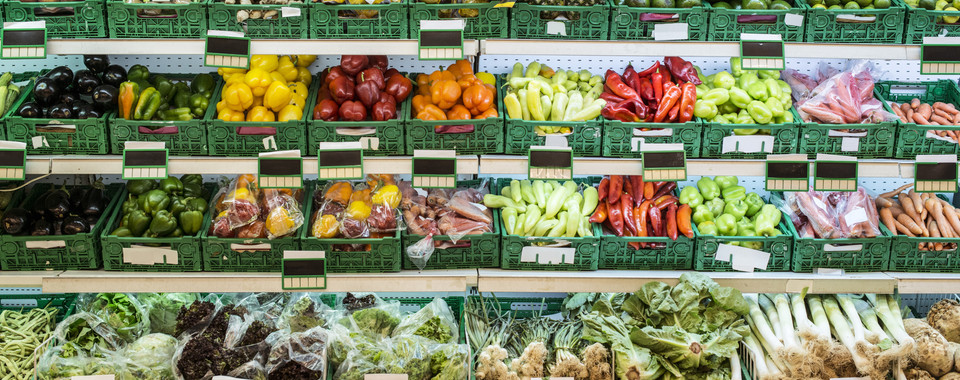
Nov 4, 2025 // Simeon Langel
Circular economy in supermarkets: The PPWR in the food retail sector
Discover how the food retail industry can navigate the EU's Packaging Regulation (PPWR) to tackle plastic waste and embrace sustainable practices.
Oct 13, 2025 Laura Skropke
ShareIn today’s supply chains, companies face immense pressure: they must make their logistics networks more resilient, cut costs, and meet increasingly strict sustainability and regulatory requirements, all at the same time. One area where these challenges converge is container management. Whether it’s small load carriers, mesh boxes, or large load containers – no industrial supply chain can function without reusable packaging.
But transparency is often lacking: Where exactly are the containers right now? How many are available at a specific site? Will there be enough packaging in the coming weeks, or are shortages on the horizon?
This is precisely where the concept of the Digital Twin comes into play. A Digital Twin is a virtual representation of a physical asset. Applied to container management, it means that every single container in the pool is given a digital counterpart that consolidates all relevant data — from its location and current status to its usage history. This makes container fleets not only visible, but also controllable and, most importantly, predictable.
A major challenge in container management is the lack of reliable information. Many companies have only a rough idea of how many containers are in circulation, but not where exactly they are or in what condition. The Digital Twin solves this problem by creating complete transparency. Every container movement can be tracked in real time: whether it’s being filled, shipped to the customer, returned for cleaning, or sent in for repair.
This level of transparency delivers immediate, measurable results. Losses and shrinkage are reduced, search times drop significantly, and decision-makers can check container inventories at the push of a button. Instead of operating blindly, they can now make data-driven decisions.
The true value of the Digital Twin unfolds when it’s combined with artificial intelligence and predictive analytics. At that point, it’s no longer just about visualizing the current state, it’s about accurately planning for the future.
By leveraging historical data and real-time information, patterns become visible: When do bottlenecks occur at specific locations? Which plants need more load carriers at certain times? How does a change in transport frequency affect the overall pool? These insights feed into predictive models that enable decision-makers to anticipate demand and take proactive action.
The result: transports can be better consolidated, cycles can be planned more efficiently, and both overstock and shortages can be avoided. Companies benefit twice - through higher efficiency and noticeable cost savings.
Beyond efficiency, sustainability has become a decisive factor in modern logistics. The EU-wide Packaging and Packaging Waste Regulation (PPWR) is putting companies under pressure to increase the recyclability and reusability of their packaging. The Digital Twin provides the critical data foundation for this.
It enables companies to prove how often a container has actually been reused, how many cycles it has completed, how long it has been in operation, and which routes it has traveled. This makes it possible to meet regulatory requirements with confidence, while also reducing CO₂ emissions through more efficient container utilization. Fewer empty runs, less overproduction, and a generally more resource-efficient use of reusable packaging directly contribute to sustainability goals.
A vivid example of how Digital Twins can be used is the launch of new production or distribution sites. Normally, it’s difficult to predict how additional facilities will affect existing container cycles. With a Digital Twin, companies can simulate these scenarios long before the first pallet or box is actually moved.
This allows them to determine how many additional containers will be required, which transport routes will experience increased load, and whether the current pooling system is sufficient. Potential bottlenecks or overcapacities can be identified early, enabling proactive adjustments. Instead of relying on trial and error, the Digital Twin enables forward-looking planning based on reliable data.
Container management is undergoing a transformation. Traditional methods can no longer keep up with the growing complexity and pace of today’s supply chains. The Digital Twin opens up entirely new possibilities: it turns container management from a reactive process, focused on tracking and corrective measures, into a proactive control instrument that puts companies back in charge of their reusable logistics.
Those who embrace Digital Twin technology today not only gain greater transparency and efficiency but also lay the foundation for sustainable and compliant supply chains. In this way, the Digital Twin becomes a key building block for future-proofing businesses, enabling them to achieve measurable savings while staying ahead in an increasingly dynamic logistics landscape.
About our Expert

Laura Skropke
Product Expert | Container and Reusable Packaging Management
Laura Skropke has been working as a Product Marketing Specialist at INFORM since September 2024. Her focus is on optimizing container and reusable packaging management and promoting sustainable, efficient circular economy solutions in logistics.